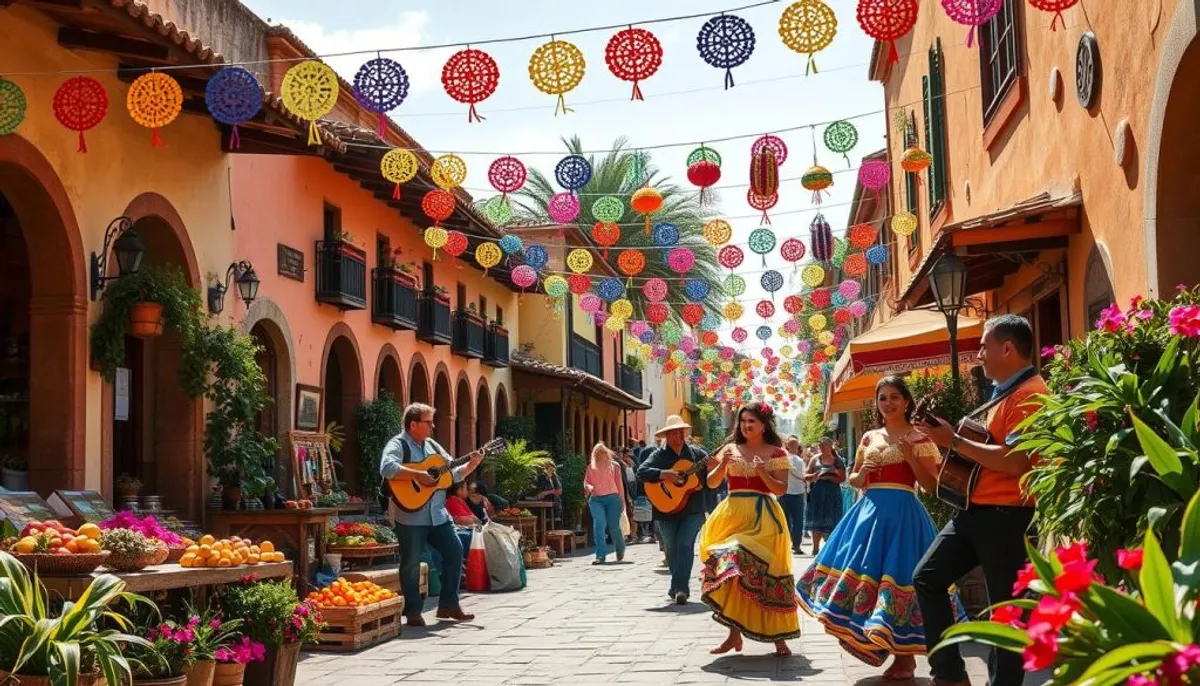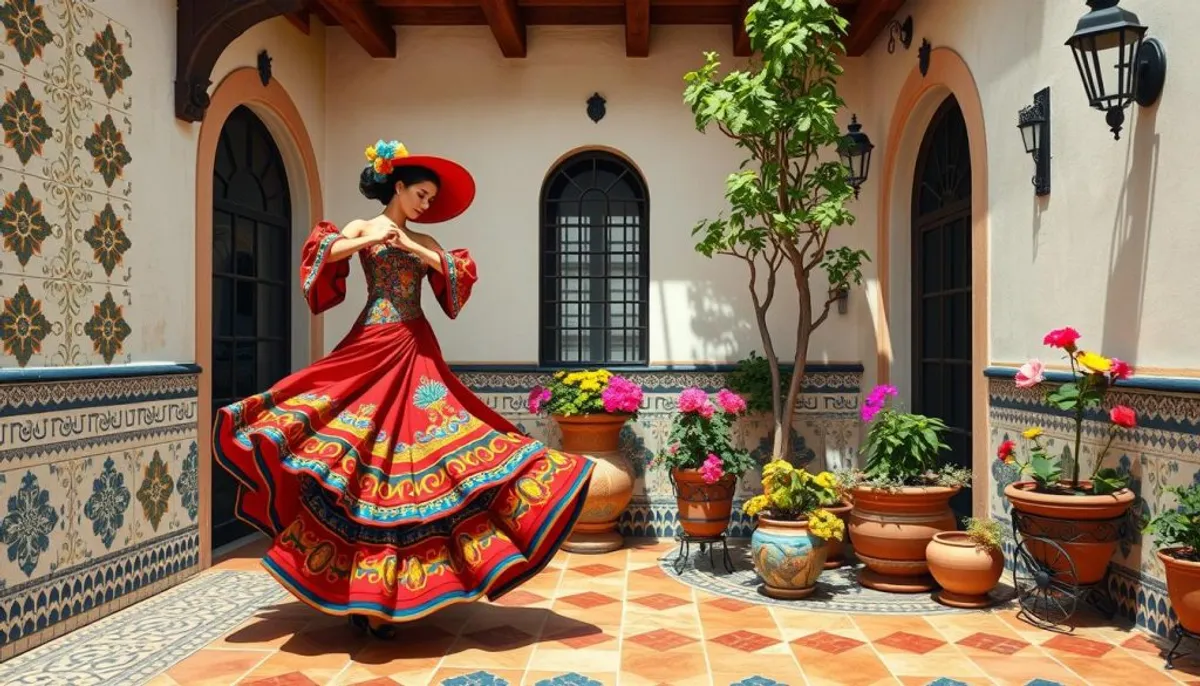The Spanish culture far exceeds the geographical limits of Spain. With more than 500 million people speaking Spanish worldwide, Hispanicity proves to be a large-scale cultural phenomenon. Spanish is indeed the second most spoken language after Mandarin, and it is official in more than 21 countries.

The Hispanic cultural heritage is of unparalleled richness. In Spain, where 47 million people live, cultural diversity is evident. Regional languages such as Catalan, Basque, and Galician play an important role. Spanish cuisine, with specialties like paella and gazpacho, illustrates this culinary diversity.
The influence of Spanish culture extends to the United States, where the Hispanic community numbers around 30 million people. Some southern states in the U.S. even publish their official documents in both English and Spanish. To enhance its international image, Spain initiated the “Marca España” in 2012. This initiative aims to highlight all aspects of its culture.
The growing influence of Hispanic culture worldwide
Hispanic culture is increasingly spreading across the globe. This expansion is due to several key factors. Among them is the presence of a significant Hispanic diaspora and the expansion of Spanish as a language.
A community of over 500 million Spanish speakers
The Spanish-speaking community is a major demographic force. In the United States, Latinos represent about 19% of the population, which is more than 62 million people in 2022. This significant presence plays a crucial role in the dissemination of Hispanic culture. To better understand this dynamic, it is useful to refer to a practical guide.

The international expansion of the Spanish language
Spanish is spreading beyond the borders of traditional Spanish-speaking countries. This linguistic expansion fosters cultural dissemination. It strengthens the international influence of Hispanic culture.
Cultural radiance beyond borders
Hispanic culture influences various fields. It penetrates music, television series, and sports on a global scale. Spain launched the Marca España in 2012 to promote its image internationally, showing its desire for cultural dissemination.
| Indicator | Value |
|---|---|
| Latino population in the United States (2022) | 62 million |
| Proportion of total population | 19% |
| Latinos holding a university degree (2020) | 20% |
| New businesses owned by Latinos | 25% |
| Latinos eligible to vote in 2024 | 32 million |
These data highlight the growing importance of the Hispanic community. They show its impact on American society. This illustrates the increasing influence of Hispanic culture worldwide.
Spanish-speaking artistic and architectural heritage
Spain shines with its rich cultural and artistic heritage. With more than 1,600 museums and collections, it offers an unparalleled insight into Spanish art through the centuries. From undisputed masters to innovative architects, the Iberian Peninsula has given birth to creators who have influenced the history of world art.
The great masters of Hispanic art
Spanish art has profoundly marked modern art. Pablo Picasso, Joan Miró, and Salvador Dalí revolutionized the artistic movements of the 20th century. Their works, displayed in the most prestigious Hispanic museums, illustrate the creativity and boldness of these artists.

Architecture, between tradition and modernity
Spanish architecture blends ancient heritage and contemporary innovation. Historical treasures like the Alhambra in Granada stand alongside modern wonders, such as the Guggenheim Museum in Bilbao. This architectural diversity contributes to the status of 15 Spanish cities as world heritage sites by UNESCO.
Must-visit museums and cultural sites
Spain is home to world-renowned museums. The Prado, the Thyssen-Bornemisza, and the Reina Sofía in Madrid form a golden triangle for art lovers. These institutions protect and enhance Hispanic artistic heritage, attracting millions of visitors each year.
| Type of heritage | Number |
|---|---|
| UNESCO sites | 49 |
| Museums and collections | 1,600+ |
| Listed monuments | 17,000+ |
| World heritage cities | 15 |
Hispanic culture or Spanish-speaking: traditions and festivities
Hispanic culture is rich in traditions and festivities that captivate the world. The Spanish festivals stand out for their energy and warmth. They are unique and captivating.
Iconic traditional celebrations
The Feria de Málaga, since 1491, transforms the city in August. It celebrates the conquest of Málaga and attracts thousands. In Catalonia, the Castellers impress with their human towers, sometimes reaching eight stories.
The night of San Juan, on June 23, brings families together. They share a festive meal, followed by fireworks. In Buñol, near Valencia, the Tomatina turns the streets into a giant battlefield.
The Spanish-speaking gastronomy
The Hispanic gastronomy is recognized worldwide. Spain, the leading producer of olive oil, also excels in citrus fruits and wine. Meal times are unique, with a late lunch and dinner around 9 PM.
- January 16: World Croqueta Day
- July 5: Horchata Festival in Alboraia
Popular cultural expressions
The Hispanic traditions manifest through various artistic forms. The classical guitar, born in southern Spain in the 18th century, is a cultural symbol. Flamenco, a blend of music and dance, embodies the soul of Andalusia.
Modern Spanish architecture fascinates, such as the Guggenheim Museum in Bilbao. These cultural expressions reinforce the international radiance of Spain. Tourism represents 11% of the national GDP.
The linguistic and literary heritage
The Hispanic cultural heritage is manifested through an unparalleled linguistic and literary richness. The Hispanic languages, particularly Spanish, are spoken by more than 500 million people. This linguistic diversity is accompanied by a rich and varied Spanish literature that has shaped history.
The diversity of Hispanic languages
In Spain, four official languages coexist: Castilian, Catalan, Basque, and Galician. This linguistic richness reflects the cultural depth of the country. In France, the specialty teaching in Spanish allows students to discover this diversity.
The great authors of Hispanic literature
Spanish literature has given birth to works that have shaped global culture. Miguel de Cervantes, author of Don Quixote, is recognized as a pioneer of the modern novel. Federico García Lorca, with his unique style, marked the 20th century. For those wishing to explore jewelry creation, a pearl buying guide can be very useful.
The influence on modern culture
The Hispanic literary heritage continues to inspire contemporary culture. In France, the study of Spanish literature is essential in school programs. A recent book explores this heritage:
| Title | Author | Year | Price |
|---|---|---|---|
| Hispano-American literature in the face of the city | Marcos Eymar | 2011 | 32 EUR |
This 338-page book, published in Paris by L'Harmattan, analyzes the work of more than a dozen Spanish-speaking authors. It illustrates the vitality and diversity of contemporary Hispanic literature.
Conclusion
Hispanic culture, or Spanish-speaking, stands out for its profound richness and diversity. With more than 500 million speakers, Spanish becomes the third most spoken language, after Mandarin Chinese and English. This linguistic expansion reflects an unparalleled cultural radiance.
The influence of Hispanic culture is felt in art. Filmmakers like Alfonso Cuarón mark global cinema. Latino artists also dominate global music charts. This growing presence enriches the world heritage.
Hispanic culture shapes the global cultural landscape. Institutions like the Instituto Cervantes promote this richness. Spanish art, with figures like Picasso and Dalí, reinforces the cultural soft power of Spain and Spanish-speaking countries.
In summary, Hispanic culture, with its millennia-old heritage and dynamism, is an essential pillar of world heritage. It reflects human diversity and creativity, opening perspectives for the future.
RelatedRelated articles


